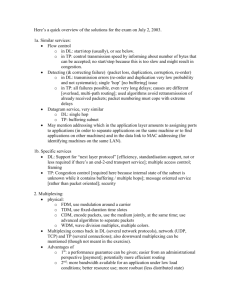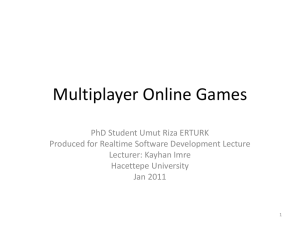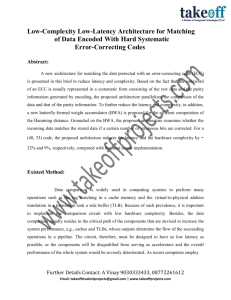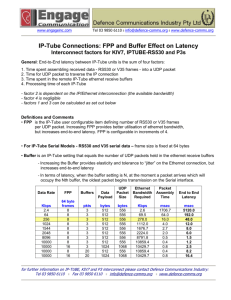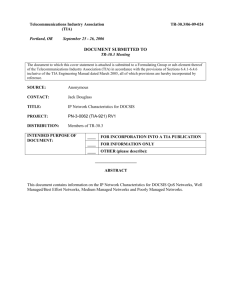ppt
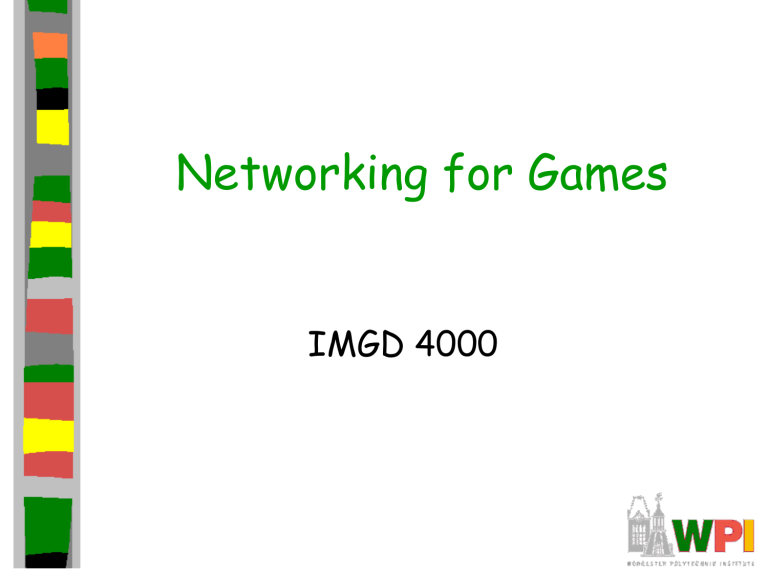
Networking for Games
IMGD 4000
Outline
•
Introduction
•
Basic Internet Architecture
•
Loss, Latency and Jitter
•
Latency Compensation Techniques
•
Playability versus Network Conditions
Introduction
•
Many design decisions and end-user experiences of multi-player, online games derive from nature of Internet
– “Best Effort” service
– Internet addressing
– Transport protocols (TCP/UDP)
•
Layered
Applications (Half-Life, WoW, Mario…)
Services (DNS, HTTP, Overlay…)
Transport (TCP,UDP)
Network (IP)
The Internet from the Edge
•
Reasonable analogy Postal Service
– Letters in envelopes
– Address envelopes
– Put in Mailbox trust that reach destination
– Don’t know how they get there
– Delivery takes different amounts of time
–
•
•
Generally, further away longer (but not always)
(ex: Use phone, or resend letter until confirmation)
•
Users view as an opaque cloud
– An Internet packet is a like a letter
– The IP address is like the address on an envelope
Provides “Best Effort” Service
•
Few guarantees on timeliness
– Take milliseconds, 100’s of milliseconds, or even seconds
•
Few guarantees on arrival certainty
– Sometimes a packet doesn’t arrive (loss)
– Or can arrive twice
– Or arrives out of order
•
Time to reach destination called latency
– Lag typically latency + end-host (server an client) time
•
Often, users have a hard time distinguishing
•
Short-term variation in latency called jitter
(More on loss, latency and jitter Chapter 5)
Endpoints and Addressing
•
•
IPv4 numerical 32-bit (4 byte) values
– Dotted quad form: 192.168.1.5
or 130.215.36.142
– In theory, 2 32 addresses, but practically fewer since allocated in blocks
Each Internet host has IP address
–
–
Client running game client
Server running game server
IPv6 has 2 128 addresses, but not widely deployed for next 10 years •
Some have 2
– Client with wireless and wired network (multi-homed)
– Router with multiple connections
•Packet has: source, destination
•Payload is upper layer
(transport, application)
•Network worries about arrival
•IP address related to, but not same as
domain name (later)
Transmission Control Protocol
•
Many applications sensitive to loss, not time
– Ex: File transfer (.exe), email
– Need reliable, ordered transfer of bytes
•
Frames data send as IP packets
•
Provides connection
•
Uses a window for outstanding packets
– Provides flow control and congestion control
– Window grows with success, shrinks with loss
– Lost packets retransmitted
Many games more sensitive to time!
Don’t use TCP
But many do!
RTS, MMO
User Datagram Protocol
•
Some applications sensitive to time
– Ex: Voice over IP (VoIP)
– Some games (First-Person Shooter)
•
Unreliable
•
Connectionless
•
No flow control (sender goes faster than receiver)
•
No congestion control (sender goes faster than network)
– Note: IP does ensure there are no bit errors (via Cyclic
Redundancy Check, CRC)
•
Lightweight, but application must handle loss!
Multiplexing and Flows
•
•
End point determined by two things:
– Host address: IP address is Network Layer
– Port number: is Transport Layer (part of IP payload)
Two end-points determine a connection: socket pair
•
– ex:
206.62.226.35,p21 + 198.69.10.2,p1500
– ex:
206.62.226.35,p21 + 198.69.10.2,p1499
Numbers (typical, since vary by OS):
– 0-1023 “reserved”, must be root
– 1024 - 5000 “ephemeral”
– Above 5000 for general use
•
Well-known, reserved services (see /etc/services in Unix):
– ftp 21/tcp
– telnet
– http
– Quake3
– Half-Life2
23/tcp
80/tcp
27960/udp
27016/udp
Unicast, Multicast, Broadcast
•
(a) Unicast, one send and one get
– Wastes bandwidth when path shared
•
(c) Broadcast, one send and all get
– Perhaps ok for LAN
– Wastes bandwidth when most don’t need
•
(b) Multicast, one send and only subscribed get
– Current Internet does not support
– Multicast overlay networks
Connectivity and Routing
•
Often edge most important
– Game developer does not see internals
•
But some aspects critical for understanding network performance
•(Label links, routers)
•Independent choice for packet based solely on destination address
Hierarchy and Aggregation
•
Value + Prefix size
– 128.80.0.0/16 all w/ 128.80
go to R1
– R1 forwards more precisely to subnet
– WPI has 130.215
with
•
130.215.28
CS subnet
•
130.215.36
CCC subnet (CCC1, …)
•
130.215.16
ECE subnet…
Routing
•
Routers use dynamic
– Discover topology
– Pick “best” routes (want tree)
•
Typically shortest path (# hops, latency…)
•
Note: Local (internal to ISP) routing protocol different than among ISPs (ASes)
– “Cost” between ASes different
Link State Routing
•
Used (w/variations) on Internet since 1979
– Open Shortest Path First (OSPF)
•
Basic steps
– Discover neighbors (upon boot)
– Experimentally measure distance
(ping/echo)
– Construct a packet telling what learned
•
(next slide)
– Send to all other routers
– Compute shortest path
•
(slide after that)
Constructing Link State Packets
•
Identity of sender, sequence number, age, list of (neighbors + distance)
Computing the Shortest Path
•
Dijkstra’s Algorithm (1959)
– Greedy algorithm (add next shortest)
–
O ( |V| 2 +|E| )
(
V vertices,
E edges)
•
Label each node with distance from source
– if unknown, then
•
As algorithm proceeds, labels change
– tentative at first
– permanent when “added” to tree
•
Note, done on each node
Dijkstra’s Algorithm: A to D
Link Layer
•
Map IP address to data link layer
– Medium Access Control (MAC)
– Ethernet (IEEE 802.3), Wi-Fi (IEEE 802.11)
– MAC address specified by vendor on card
– 48-bit: 00:0F:1F:81:41:6C
•
Assignment:
– Fixed (register with netops)
– Dynamic (assigned when boot)
Miscellaneous
•
Time-to-Live
– Prevent loops (routers may have different shortestpath trees)
– 8-bit value (0 to 255)
– Decrement by one each hop
– If zero, then discard ifconfig (Linux) ipconfig /all (Windows)
•
Maximum Transmission Unit (MTU)
– IP packet could be 64 kbytes
– In practice, bound by Ethernet (prevalent standard)
1500 byte payload, so 1460 application
•
If larger, then fragment into multiple IP packets
– Re-assemble at end
– If one lost, all lost!
•
First Hop
– Only know egress (ie- first router)
Address Management
Mini-Outline
•
Network Address Translation
•
Dynamic Host Configuration Protocol
•
Dynamic Name Service
Network Address Translation (NAT)
(1 of 2)
•
Used at boundary of ISP
– Where internal address on publicly routable external address
•
Good if internal address not allocated
– Ex: private networks
•
10/8, 172.16/12, 192.168/16
•
Also, may help keep internal network secure (but not sufficient)
Network Address Translation (NAT)
(2 of 2)
•
Source hosts use private IP
•
Forward to NAT router
•
•
Swap source address with public address (could be range)
•
Send to ISP
Remember process so can do reverse on return
Network Address Port Translation
(1 of 2)
•
Have only 1 public IP for multiple private IP computers
Network Address Port Translation
(2 of 2)
•
Easy to renumber (one number)
•
Only need one IP
•
Breaks transparency (need to add functionality for each new protocol)
•
Hard for outside hosts to access inside
– Ex: what if two different Quake3 servers inside?
– Need non-standard ports that clients know about
•
Typically, local server register w/master server
– Gives IP + Port where server is
– Need to configure NAT box to forward ports
Dynamic Host Configuration Protocol
(DHCP)
•
Hosts need: IP address, subnet mask, IP of at least one router
– Use DHCP to get from a LAN device
•
Typical with WLAN router, cable modem, …
•
Client broadcasts DHCP discovery to port 67
– Identifies its MAC
•
DHCP server responds w/IP + Mask + Router IP
•
Client confirms, selects from server (could be more than one DHCP server)
•
Server ACKs
Domain Name System
•
Map text names to IP address
– Ex: www.wpi.edu
mapped to
130.215.36.26
– Names more humanreadable
•
Minimal <name>.tld
(toplevel-domain)
– tld:
.com, .gov, .edu
– tld: .au, .fr, .uk
nslookup, dig, host
•
Hierarchy
– Distributed name servers
– Know first one, it knows upper level
– Local responses cached
•
Local DNS, and at host
Outline
•
Introduction
•
Basic Internet Architecture
•
Loss, Latency and Jitter
•
Latency Compensation Techniques
•
Playability versus Network Conditions
(done)
(done)
(next)
Latency, Jitter and Loss
(See Picture next slide)
•
3 characteristics most identified with IP networks
– Note: bandwidth? Sometimes. (More later)
•
Loss - packet does not arrive
– Usually, fraction #recv/#sent , p
[ 0:1 ]
– Note, often assumed independent but can be bursty
(several lost in a row)
•
Latency - time to get from source to destination
– Round trip time (RTT) often assumed to be
2*latency, but network path can be asymmetric
•
•
Jitter - variation in latency
•
How much does each matter? (Chapter 7, later)
Right now, sources for each
Latency, Jitter and Loss
Sources of Loss
•
Note, here we are considering only IP packet loss
– Above IP, TCP will retransmit lost packets
– Below IP, data link layer often retransmits or does repair (Forward
Error Correction)
•
IP packet loss predominantly from congestion
– Causes queue overflow
– Congestion
•
Bit errors
– More common on wireless
•
•
Loss during route change (link/host unavailable)
Often bursty!
Router
Routing
Table
Packet queue
Sources of Latency
Mini-Outline
•
Propagation
•
Serialization
•
Congestion
Sources of Latency -
Propagation Delay
•
•
Time for bits to travel from one host to another
Limited by propagation speed of medium
– Typically electricity/light through cable or fiber
– Could be radio wave through air
– Could even be sound wave through water!
•
Roughly: latency (ms) = length of link (km) / 300
•
Ex: Worcester, MA to Berkeley, CA is 2649 miles
(4263 km)
•
Notes: latency = 4263 / 300 = 14 msec
– Light through fiber about 30% slower than light through vacuum
– Paths often not in a straight line
Sources of Latency -
Serialization Delay
•
Ex: Consider everyone trying to leave room by one door
– Exit only at fixed rate
– Similar to transmitting bits by a network card
•
Time to transmit packet on link 1 bit at a time serialization
•
Serialization delay for each hop (cumulative)
•
Includes headers (26 bytes for Ethernet) latency (ms) = 8 * link layer frame (bytes) / link speed (kbps)
•
Ex: 1000 byte app data, uplink typical DSL rate
– Frame is 1000 + 40 (UDP/IP) + 26 (Ethernet) latency = 8 * 1066 / 192 = 44 msec
Sources of Latency -
Queuing Delay
•
When traffic rate bursty, unpredictable rate
(unlike, say, phone)
– Need to handle burst queue
•
Queuing delay latency (ms) = 8 * queue length (packets) * avg pckt sz (bytes) / link speed (kpbs)
•
Ex: 10 packets, each 1000 bytes, 1 Mbps link latency = 8 * 10 * 1000 / 1000 = 80 msec
•
Note, can have at end-host, too, when send faster than link (ie- WLAN) ping, traceroute ( Linux ), tracert ( Windows )
Sources of Jitter
•
Due to a change in end-to-end delay from one packet to the next
•
•
Route changes
Queue length changes
•
– Say, goes from 10 (80 msec delay) to 0
Packet length changes (serialization different)
– Big packet (1000 bytes) 44 msec
– Small packet (10 bytes) 4.4 msec
– Could be from other packets in the queue, too
Tools
•
ping
– http://www-iepm.slac.stanford.edu/pinger/
•
traceroute
– http://www.traceroute.org
• bandwidth estimation
– http://www.speedtest.net/index.php
– http://speedtest.verizon.net/SpeedTester/help_speedtest.jsp
•Note, ~145 ms (12,000 km Sydney to LA) when estimate is 80 ms
Latency Compensation
Mini-Outline
•
Need
•
Prediction
•
Time delay and Time warp
•
Data compression
•
Visual tricks
•
Cheating
Need for Latency Compensation
•
Bandwidth is growing, but cannot solve all problems
•
Still bursty, transient congestion (queues)
•
Bandwidth upgrade uneven across all clients
– Modems? Maybe. DSL, yes, but even those vary in downlink/uplink.
•
WWAN growing (low, variable bandwidth, high latency)
•
Propagation delays (~25 msec minimum to cross country)
“There is an old network saying: ‘Bandwidth problems can be cured with money.
Latency problems are harder because the speed of light is fixed – you can’t bribe
God.’ ” —David Clark, MIT
Basic Client-Server Game Architecture
•
•
“Dumb” client
Server keeps all state
•
•
Validates all moves
Client only updates when server says “ok”
Algorithm
•
Sample user input
•
Pack up data and send to server
•
Receive updates from server and unpack
•
Determine visible objects and game state
•
Render scene
•
Repeat
User
Input
Render
Input
Message:
User Input
Message:
Ok User Input
Time
Process and
Validate
Input
Latency Example (1 of 2)
Player is pressing left Player is pressing up
Running back goes out of bounds
Latency Example (2 of 2)
Player is pressing
“pass”
Pass starts rendering
Interception
Compensating for Latency - Prediction
•
Broadly, two kinds:
– Player prediction
– Opponent prediction (often called “dead reckoning” but that name does little to help remember)
Player Prediction
User
Input
Render
Input
Fix
Up
Message:
User Input
Message:
Ok with Update
Time
Process and
Validate
Input
Predicted Algorithm
•
Sample user input
•
Pack up data and send to server
•
Determine visible objects and game state
•
Render scene
•
Receive updates from server and unpack
•
Fix up any discrepancies
•
Repeat
Tremendous benefit. Render as if local, no latency.
But, note, “fix up” step additional. Needed since server has master copy.
Example of State Inconsistency
•
Predicted state differs from actual state
Prediction Tradeoffs
•
Tension between responsiveness (latency compensation) and consistency.
Client uses prediction
More responsive,
Less consistent
Client waits for server ok
Less responsive,
More consistent
Opponent Prediction
•
•
Opponent sends position, velocity (maybe acceleration)
Player predicts where opponent is t
0 t
1
Unit Owner
Actual Path send initial position send update t
3 t
2 send update send update
Opponent
Predicted Path
(User can see “Warp” or “Rubber band”.)
Opponent Prediction Algorithms
Unit Owner
•
Sample user input
•
Update { location | velocity
| acceleration } on the basis of new input
•
Compute predicted location on the basis of previous {location | velocity | acceleration}
•
If (current location – predicted location) < threshold then
–
Pack up {location | velocity
| acceleration) data
–
Send to each other opponent
•
Repeat
Opponent
•
Receive new packet
•
Extract state update information
{ location | velocity | acceleration }
•
If seen unit before then
– Update unit information
• else
– Add unit information to list
•
For each unit in list
– Update predicted location
•
Render frame
•
Repeat
Opponent Prediction Notes
•
Some predictions easy
– Ex: falling object
•
Others harder
– Ex: pixie that can teleport
•
Can be game specific
– Ex: Can predict “return to base” with pre-defined notion of what “return to base” is.
•
Cost is each host runs prediction algorithm for each opponent.
•
Also, although a latency compensation method, can greatly reduce bitrate.
– Predict self. Don’t send updates unless needed.
– Especially when objects relatively static.
Time Manipulation
•
Client states can differ
– Depends upon their RTT to server
•
Impacts fairness
– Ex: Two players defeat monster
– Server generates treasure. Sends messages to clients.
– Clients get messages. Players can react.
– Client closer (RTT lower) gets to react sooner, gets treasure
•
Unfair!
•
Solution? Manipulate time
– Time Delay
– Time Warp
Time Delay
•
Server delays processing of events
– Wait until all messages from clients arrive
– (Note, game plays at highest RTT)
•
Server sends messages to more distant client first, delays messages to closer
– Needs accurate estimate of RTT
Client 1 command arrives
Client 2 command arrives
Server processes both client commands
Time
Time Delay
Time Warp
•
In older FPS (ie- Quake 3), used to have to lead opponent to hit
– Otherwise, player had moved
– Even with “instant” weapon!
•
Knowing latency roll-back
(warp) to when action taken place
– Usually assume ½ RTT
Time Warp Algorithm
•
Receive packet from client
•
Extract information (user input)
• elapsed time = current time – latency to client
•
Rollback all events in reverse order to current time – elapsed time
•
Execute user command
•
Repeat all events in order, updating any clients affected
•
Repeat
Time Warp Example
•
•
Client 100 ms behind
•
Still hits (note the blood)
Also, note the bounding boxes
Time Warp Notes
•
Inconsistency
– Player target
– Move around corner
– Warp back hit
– Bullets seem to “bend” around corner!
•
Fortunately, player often does not notice
– Doesn’t see opponent
– May be just wounded
Data Compression
•
Idea less data, means less latency to get it there
– So, reduce # or size of messages reduce latency
(serialization)
•
Lossless (like zip)
•
Opponent prediction
– Don’t send unless need update
•
Delta compression (like opponent, but more general)
– Don’t send all data, just updates
•
Interest management
– Only send data to units that need to see it
Interest Management
Where are you?
Hider’s
Nimbus
Hider’s
Focus
Seeker’s
Focus Seeker’s
Nimbus
Data Compression (continued)
•
Peer-to-Peer (P2P)
– Limit server congestion
– Also, client1 server client2 higher latency than client1 client2
– But cheating especially problematic in P2P systems
•
Update aggregation
– Message Move A Send C, Move B Send C
– Instead, Move A + Move B Send C
– Avoid packet overhead (if less than MTU)
– Works well w/time delay
Visual Tricks
•
Latency present, but hide from user
– Give feeling of local response
•
Ex: player tells boat to move, while waiting for confirmation raise sails, pull anchor
•
Ex: player tells tank to move, while waiting, batten hatches, start engine
•
Ex: player pulls trigger, make sound and puff of smoke while waiting for confirmation of hit
Latency Compensation and Cheating
•
Opponent prediction no server is needed!
– Yes, if player can be trusted
– Else “I just shot you in the head” how to verify?
•
Time warp client pretends to have high latency
– Can pass to player then react
– Worse if client controls time stamps
•
Interest management can help with information exposure
Networking and Playability
•
Latency affects performance
– Subjective and Objective
But depends upon task!
Precision and Deadline
Precision Example
Shooting an opponent in a FPS Game
(a) high precision weapon
(b) low precision weapon
Deadline Example
Moving in a FPS Game
(a) Loose deadline
(b) Tight deadline
Player Performance vs. Latency
Player Performance vs. Latency
Networking Cheating in General
•
Unique to games
– Other multi-person applications don’t have
– In DIS, military not public and considered trustworthy
•
Cheaters want:
– Vandalism – create havoc (relatively few)
– Dominance – gain advantage (more)
Packet and Traffic Tampering
•
Reflex augmentation - enhance cheater’s reactions
– Example: aiming proxy monitors opponents movement packets, when cheater fires, improve aim
•
Packet interception – prevent some packets from reaching cheater
– Example: suppress damage packets, so cheater is invulnerable
•
Packet replay – repeat event over for added advantage
– Example: multiple bullets or rockets if otherwise limited
Preventing Packet Tampering
•
Cheaters figure out by changing bytes and observing effects
– Prevent by MD5 checksums (fast, public)
•
Still cheaters can:
– Reverse engineer checksums
– Attack with packet replay
•
So:
– Encrypt packets
– Add sequence numbers (or encoded sequence numbers) to prevent replay
Information Exposure
•
Allows cheater to gain access to replicated, hidden game data (i.e. status of other players)
– Passive, since does not alter traffic
– Example: defeat “fog of war” in RTS, see through walls in FPS
•
Cannot be defeated by network alone
•
Instead:
– Sensitive data should be encoded
– Kept in hard-to-detect memory location
– Centralized server may detect cheating (example: attack enemy could not have seen)
•
Harder in replicated system, but can still share
Design Defects
•
If clients trust each other, then if client is replaced and exaggerates cheater effects, others will go along
– Can have checksums on client binaries
– Better to have trusted server that puts into play client actions (centralized server)
•
Distribution may be the source of unexpected behavior
– Features only evident upon high load (say, latency compensation technique)
– Example: Madden Football
Summary
•
Networking increasingly important for games
– The network is the computer
– Many games come with online play, downloads, player communities
•
Internet influences design of game architecture
– Need to live with “best effort” service
•
Choice of solution (latency compensation or transport protocol) depends upon action within game

